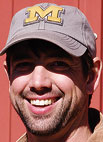
A trade 76 years ago laid the foundation for Steve Greene’s new career. In 1936, Bonebrake Herefords was established in Salem, Mo., after Mr. Bonebrake traded his herd of sheep and a shotgun for Herefords from a man in Illinois. Since then, the farm has expanded from it’s original location to include 400-acres in Greene County.
Today, Steve Greene now manages the Hereford ranch just outside Springfield, Mo., for Dr. Mac and Dr. Al Bonebrake where he and his wife, Jessica, reside.
When Steve took over as the ranch manager two years ago he began focusing on efficiency considering every aspect from data collection to fuel costs to synchronization.
“Right now we have 71 registered Hereford momma cows,” explained Steve. But our biggest operation is selling registered Hereford bulls.”
Since the Hereford Association combined the polled and horned registry the market has expanded tremendously for Steve. “Bonebrake was strictly horned bulls but now with the new registration guidelines we are able to ‘crossbreed’ within the breed, so to speak. We aren’t loyal to polled or horned we supply whatever our customers want,” Steve clarified.
Bonebrake starts advertising their bulls as yearlings once they have completed a semen check and collected EPDs. As a general guideline no bull is kept if they do not have a weaning weight of 550 pounds or more. Calves are fence-line weaned at seven months.
The Hereford bulls are on a strict nutritional plan. They are fed 8 to 10 pounds per day of bull grower from Main Street Feeds along with free choice mineral, hay and limited pasture. The goal is for each bull to gain an average of 3 pounds per day. “I like to see our bulls weigh 1,100 pounds as yearlings,” said Steve.
To improve profits Steve has implemented a synchronized AI program. “We purchase semen from up and coming bulls and we pay close attention to EPDs,” stated Steve.
Steve commented that he is just now starting to see good results from the newly designed breeding program. Most of the heifers now are AI sires offering better EPDs. “Maybe in another year I’ll be right where I want to be after getting rid of a few problem cows,” Steve predicted.
Embryo transfers offer another option for building up the herd faster. “We have an older cow who has been a really good producer for us so we flushed her. We got really good results so we bought some more cows and will put eggs in them the beginning of May,” explained Steve.
Bonebrake implements a very in depth vaccination program including vaccinations for Lepto, Vibrio and Blackleg. All animals are dewormed twice a year. One important aspect to their animal health program is the administration of a multi-vitamin shot to the females before breeding, to calves and to yearling bulls.
Steve’s need to call on a vet is minimal from the combination of his degree in animal science and years of hands-experience in the beef industry having grown up on a farm in Morrisville, Mo. Steve does rely on a vet for pregnancy checking in order to cull as quickly as possible.
Rotational grazing is essential to the overall profit efficiency of the farm. The farm is divided into 12 paddocks that are utilized year round.
Three of the paddocks are warm season grass pastures. “If you use it right you can break the cycle of too much Fescue, which can be toxic. Grazing warm season grasses cuts back on abortion, increases conception rates and eliminates missing tail switches. I put the cows on warm season pastures during the hottest months of summer,” said Steve.
Although Steve runs the daily operations of the farm Al has a tremendous interest in the farm and the Herefords. “Al wants to see the Herefords do well whether in the show ring, sale ring or in someone’s pasture. Everything I do on the farm he has an input,” concluded Steve.







